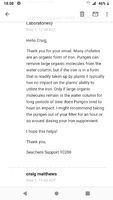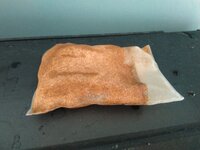I agree Zeus because as Darrel stated the complex compound of iron but when we have chelated mixes of ferts is it just our iron that is chelated into a more complex compound making it easier for purigen to grab a hold or other micro's too?
-
You are viewing the forum as a Guest, please login (you can use your Facebook, Twitter, Google or Microsoft account to login) or register using this link: Log in or Sign Up
You are using an out of date browser. It may not display this or other websites correctly.
You should upgrade or use an alternative browser.
You should upgrade or use an alternative browser.
FE EDDHA
- Thread starter Craig Matthews
- Start date
Hi all,
Somebody could ask on the <"Seachem forum">, although I suspect the response would need a certain amount of "interpretation". There is a thread, but it isn't <"very informative">.
cheers Darrel
Yes, I would think it would.So if the Purigen is mopping up the FeEDHHA which I think is fairly conclusive from the observations of Craig, I can see no reason why it should mop up the FeEDTA or FeDTPA as well
Somebody could ask on the <"Seachem forum">, although I suspect the response would need a certain amount of "interpretation". There is a thread, but it isn't <"very informative">.
cheers Darrel
I will try ask tonight, interesting thread and how the seachem support likes to turn to blaming the water supply.
Interesting, so if EDTA is bound by purigen then higher more complex chelates, DTPA and of course eddha are most certainly bound by purigen. That confirms Zeus's thoughts. If after regeneration the purigen releases chloromines that's potentially becoming toxic to live stock?
Hi all,
cheers Darrel
I think it is probably a theoretical concern for planted tank keepers, because the plants are going to mop up any trickle of ammonia (from the breakdown of chloramine) fairly effectively.If after regeneration the purigen releases chloromines that's potentially becoming toxic to live stock?
cheers Darrel
So seachem got back to me with the following reply, Darrell's philosophy is %100 correct regarding the large molecular size of the chelates. I suppose it depends how quickly the plants uptake the iron for any consequences with the purigen?
Attachments
Hi all,
cheers Darrel
Somebody could ask on the <"Seachem forum">, although I suspect the response would need a certain amount of "interpretation".
Fair play to Seachem, that is a pretty straight-forward and unequivocal answer.So seachem got back to me with the following reply
Yes. The more efficient the chelator is the more likely it is to be bound by the purigen. In very hard water (where you would be more likely to FeEDDHA) any iron (Fe++(+)) ions will be mopped up pretty quickly by carbonate (HCO3-), hydroxide (OH-) or phosphate (PO4---) anions and will form insoluble compounds.. I suppose it depends how quickly the plants uptake the iron for any consequences with the purigen?
cheers Darrel
Damn, It sounds like I'm fighting a losing battle with my hard water, po4 from the tap, purigen I can remove easily. My Fe eddha or any iron chelate for this matter just gets bound one way or another, RO seems the only light at the end if the tunnel.
PARAGUAY
Member
I have emailed Seacham in the past( a test kits query) and got a very good response from the technical side aggreing with UKAPS a lot about their limitations -- and also the benifits, and they were pretty generous about some of their competitors
Hi all,
The same applies to watching the "pink tinge" in the water, it is an easy visual way of telling whether you have iron present
I'm a rain-water user, it gives you some of the advantages of RO, and gets around the issue of chlorination and waste of water.
cheers Darrel
I'd just see what happens. Plants just need a trickle of iron, they don't need very much. If your plant health is good, with green, normally sized new leaves, then the plants are getting enough iron. That is why I like the response of a <"non-CO2 limited plant as a visual indicator of nutrient levels">, it does a way with a lot of agonising and testing etc.I'm fighting a losing battle with my hard water, po4 from the tap
The same applies to watching the "pink tinge" in the water, it is an easy visual way of telling whether you have iron present
I'd take it out, otherwise it is constantly going to be fouled by the FeEDDHA and you are going to get through a lot of Purigen......purigen I can remove easily.
RO works because it is a "blank slate", the only things in your tank water are the things you've added. Against that you have the expense and environmental impact.RO seems the only light at the end if the tunnel.
I'm a rain-water user, it gives you some of the advantages of RO, and gets around the issue of chlorination and waste of water.
cheers Darrel
Well I've recently acquired some hornwart to I might float abit rather than plant in the substrate see how it reacts. Cheers Darrel I will take the purigen out and delete any possible negative side effects on the FE.
Have a good weekend
Have a good weekend
Hi all,
cheers Darrel
Ceratophyllum spp. are always really floaters, even if you anchor them. Hornwort has been used as a <"model plant"> for plant physiology studies on leaves, because it doesn't have the capacity to ever develop any <"roots">.I've recently acquired some hornwart. I might float abit rather than plant in the substrate
It occurs on all the continents other than (Antarctica) and can grow in a wide range of water hardness, so I would expect that it is pretty efficient at taking up those ions that are in short supply in hard water (like Fe+++). It can definitely use bicarbonate (HCO3-) as <"a carbon source">, which is usually a good indication of adaptation to hard water.... see how it reacts
cheers Darrel
Aha I see, I did read that hornwart is a floating plant but can be anchored in substrate, it does not develop roots but something similar to enable anchoring? I've taken the purigen out so I'll give it a week or two and keep an eye on the pink tinge.you can see the purigen colour, admittedly it is somewhat brown from bio and waste but there is a red hue to it. Seachem state it should last around 6 months I think they say it works out at 1 gram for every gallon so this bag is 100 grams=100 gallons and my tank is only 30 gallons way below their stated threshold and I'm not over stocked so alot of the colour is indeed FE EDDHA
Attachments
Hi all,
I assume people anchor it by planting the base of the stem in the substrate, and presumably they keep on doing this every time it floats free.
cheers Darrel
Whenever I've seen it in the wild it has been free floating, and the same in my tanks and <"water buckets">.it does not develop roots but something similar to enable anchoring?
I assume people anchor it by planting the base of the stem in the substrate, and presumably they keep on doing this every time it floats free.
cheers Darrel
@dw1305 Been thinking about rainwater rather than using RO and could pick up some more water butts 240L which if it rains would be ideal and just pump some of the rainwater into the tank say 50:50 with tap water, but average WC uses about 200-300l weekly, so some weeks might not have enough to have the same mix every week dependant on rainfall OFC so was thinking does it need to be the same mix every week ? so if no water in butt use straight from tap if I have enough rain water mix it up. The water harness would vary week to week and the target pH OFC but would the plants suffer ? after all water in rivers and streams will vary also with the rainfall
Hi all,
If I was getting through a 150L a week, I'd be looking at as much as 10,000 litres of rain-water storage.
cheers Darrel
I've got about a thousand litres of rain-water storage, I use a bit of it for watering the containers, but mostly for the water changes in the tanks and I still run short at some times when its dry.Been thinking about rainwater rather than using RO and could pick up some more water butts 240L which if it rains would be ideal and just pump some of the rainwater into the tank say 50:50 with tap water, but average WC uses about 200-300l weekly,
If I was getting through a 150L a week, I'd be looking at as much as 10,000 litres of rain-water storage.
cheers Darrel
X3NiTH
Member
- Joined
- 13 Apr 2014
- Messages
- 1,669
Might be too much of a dKH swing if hopping between rain 50:50 and 100% tap. Different scenario but same effect, I've stupidly just managed to start melt down in my Buce again by swapping out inert substrate for what appeared to be inert sand that turned out to have crushed coral in it, the addition of CO₂ in this tank made the dKH go from a consistent 8 to 20 and climbing and it's pretty catastrophic on the plants, even my Narrow mini leaf Java fern has gone glassy and started melting (much more sensitive to changing conditions than regular Java fern, like Buce it is agonising that it takes so long to grow and I've now lost over 50% of it sigh). The same sand I had been using for a few weeks in a non CO₂ injected tank and that has remained inert at dKH8 which is why I thought it was inert to use elsewhere, I should have checked, my bad.
Hi all,Ceratophyllum spp. are always really floaters, even if you anchor them. Hornwort has been used as a <"model plant"> for plant physiology studies on leaves, because it doesn't have the capacity to ever develop any <"roots">.It occurs on all the continents other than (Antarctica) and can grow in a wide range of water hardness, so I would expect that it is pretty efficient at taking up those ions that are in short supply in hard water (like Fe+++). It can definitely use bicarbonate (HCO3-) as <"a carbon source">, which is usually a good indication of adaptation to hard water.
cheers Darrel
So my planted hornwort has taken a turn for the worst, needles have gone from green, yellow and now browning so dying. Can I pin this on the fact that it's a floating plant? I'm not 100% sure as I'm finding all my plants are growing, slowly but the older growth as in the leaf before the new one very quickly dies and gets BBA so I'm guessing co2 problem, don't think it's light as I have just a fluval 2.0 over a juwel Rio 125 at about 500mm above substrate level so I'd say that low light.




